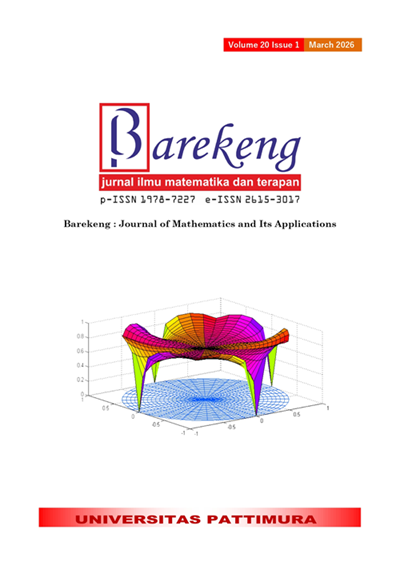MATHEMATICAL MODEL OF THE SPREAD OF HIV/AIDS CONSIDERING THE LEVEL OF IMMUNITY
Abstract
The immune system, crucial for defending the body against infections, is a primary target of HIV, compromising its ability to resist illnesses that may progress to AIDS. This study develops a mathematical model incorporating the immune response to simulate HIV/AIDS transmission dynamics. The model analysis includes the determination of equilibrium points, the basic reproduction number , and bifurcation behavior. Two equilibrium points are identified: the disease-free and endemic equilibria. The disease-free equilibrium is asymptotically stable when , while the endemic equilibrium is stable when , indicating persistent transmission. A forward bifurcation occurs at , which biologically implies that reducing below one is critical for eliminating the disease. Numerical simulations using actual data yield an estimated with a Mean Absolute Percentage Error (MAPE) of 4.5583%, indicating good agreement between the model and data. Although the model assumes homogeneous mixing and constant parameters, it provides meaningful insights into HIV/AIDS transmission and offers a quantitative basis for evaluating control strategies.
Downloads
References
S. W. Teklu and T. T. Mekonnen, “HIV/AIDS-PNEUMONIA COINFECTION MODEL WITH TREATMENT AT EACH INFECTION STAGE: MATHEMATICAL ANALYSIS AND NUMERICAL SIMULATION,” J. Appl. Math., vol. 2021, no. Cdc, 2021, doi: https://doi.org/10.1155/2021/5444605.
S. W. Teklu and B. B. Terefe, “COVID-19 AND SYPHILIS CO-DYNAMIC ANALYSIS USING MATHEMATICAL MODELING APPROACH,” Front. Appl. Math. Stat., vol. 8, pp. 10–16, 2023, doi: 1https://doi.org/10.3389/fams.2022.1101029.
T. K. Ayele, E. F. Doungmo Goufo, and S. Mugisha, “MATHEMATICAL MODELING OF HIV/AIDS WITH OPTIMAL CONTROL: A CASE STUDY IN ETHIOPIA,” Results Phys., vol. 26, p. 104263, 2021, doi: https://doi.org/10.1016/j.rinp.2021.104263.
F. Khademi, A. Yousefi-Avarvand, A. Sahebkar, F. Ghanbari, and H. Vaez, “BACTERIAL CO-INFECTIONS IN HIV/AIDS-POSITIVE SUBJECTS: A SYSTEMATIC REVIEW AND META-ANALYSIS,” Folia Med. (Plovdiv)., vol. 60, no. 3, pp. 339–350, 2018, doi: https://doi.org/10.2478/folmed-2018-0007.
O. O. Apenteng, P. P. Osei, N. A. Ismail, and A. Chiabai, “ANALYSING THE IMPACT OF MIGRATION ON HIV/AIDS CASES USING EPIDEMIOLOGICAL MODELLING TO GUIDE POLICY MAKERs,” Infect. Dis. Model., vol. 7, no. 1, pp. 252–261, 2022, doi: https://doi.org/10.1016/j.idm.2022.01.002.
S. O. Oyovwevotu, “MATHEMATICAL MODELLING FOR ASSESSING THE IMPACT OF INTERVENTION STRATEGIES ON HIV/AIDS HIGH RISK GROUP POPULATION DYNAMICS,” Heliyon, vol. 7, no. 10, p. e07991, 2021, doi: https://doi.org/10.1016/j.heliyon.2021.e07991.
UNAIDS, “IN DANGER: UNAIDS GLOBAL AIDS UPDATE 2022,” Geneva Jt. United Nations Program. HIV/ AIDS; 2022. Licence CC BY-NC-SA 3.0 IGO, 2022, doi: https://doi.org/10.18356/9789210019798.
Kementerian Kesehatan Republik Indonesia, “PERKEMBANGAN HIV AIDS DAN PENYAKIT INFEKSI MENULAR SEKSUAL (PIMS) TAHUN 2022,” 2022.
X. C. Li et al., “GLOBAL BURDEN OF VIRAL INFECTIOUS DISEASES OF POVERTY BASED ON GLOBAL BURDEN OF DISEASES STUDY 2021,” Infect. Dis. Poverty, vol. 13, no. 1, pp. 1–15, 2024, doi: https://doi.org/10.1186/s40249-024-01234-z.
A. Kouidere, O. Balatif, and M. Rachik, “COST-EFFECTIVENESS OF A MATHEMATICAL MODELING WITH OPTIMAL CONTROL APPROACH OF SPREAD OF COVID-19 PANDEMIC: A CASE STUDY IN PERU,” Chaos, Solitons Fractals X, vol. 10, p. 100090, 2023, doi: https://doi.org/10.1016/j.csfx.2022.100090.
N. T. Sapulette, Y. A. Lesnussa, and M. E. Rijoly, “DYNAMICS OF A SIRV MODEL FOR THE SPREAD OF COVID-19 IN MALUKU PROVINCE,” BAREKENG J. Math. Its Appl., vol. 17, no. 3, pp. 1673–1684, 2023.doi: https://doi.org/10.30598/barekengvol17iss3pp1673-1684
A. Wiraya, Y. A. Adi, L. Fitriana, and A. Putri, “GLOBAL STABILITY OF DISEASE-FREE EQUILIBRIA IN COVID-19 SPREAD THROUGH LIVING AND INANIMATE OBJECTS MATHEMATICAL MODEL,” BAREKENG J. Math. Its Appl., vol. 17, no. 4, pp. 1873–1884, 2023.doi: https://doi.org/10.30598/barekengvol17iss4pp1873-1884
N. H. Sweilam, Z. N. Mohammed, and W. S. Abdel kareem, “NUMERICAL TREATMENTS FOR A MULTI-TIME DELAY COMPLEX ORDER MATHEMATICAL MODEL OF HIV/AIDS AND MALARIA,” Alexandria Eng. J., vol. 61, no. 12, pp. 10263–10276, 2022, doi: https://doi.org/10.1016/j.aej.2022.03.058.
M. Z. Ndii and Y. A. Adi, “UNDERSTANDING THE EFFECTS OF INDIVIDUAL AWARENESS AND VECTOR CONTROLS ON MALARIA TRANSMISSION DYNAMICS USING MULTIPLE OPTIMAL CONTROL,” Chaos, Solitons and Fractals, vol. 153, 2021, doi: https://doi.org/10.1016/j.chaos.2021.111476.
S. Y. Tchoumi, N. Y. Njintang, J. C. Kamgang, and J. M. Tchuenche, “MALARIA AND MALNUTRITION IN CHILDREN: A MATHEMATICAL MODEL,” Franklin Open, vol. 3, no. February, p. 100013, 2023, doi: https://doi.org/10.1016/j.fraope.2023.100013.
M. M. Ojo and E. F. Doungmo Goufo, “THE IMPACT OF COVID-19 ON A MALARIA DOMINATED REGION: A MATHEMATICAL ANALYSIS AND SIMULATIONS,” Alexandria Eng. J., vol. 65, pp. 23–39, 2023, doi: https://doi.org/10.1016/j.aej.2022.09.045.
Z. A. Leleury, F. Y. Rumlawang, and A. G. Naraha, “ANALISIS STABILITAS DAN SIMULASI MODEL PENYEBARAN PENYAKIT HIV/AIDS TIPE SIA (SUSCEPTIBLE, INFECTED, ABSTAINED),” Pure Appl. Math. J., vol. 1, no. 1, pp. 31–40, 2020.doi: https://doi.org/10.30598/tensorvol1iss1pp31-40
M. Z. Ndii, Y. A. Adi, and B. S. Djahi, “DETERMINISTIC AND STOCHASTIC DENGUE EPIDEMIC MODEL : EXPLORING THE PROBABILITY OF EXTINCTION,” BAREKENG J. Math. Its Appl., vol. 16, no. 2, pp. 583–595, 2022.doi: https://doi.org/10.30598/barekengvol16iss2pp583-596
Y. A. Adi and Suparman, “AN INVESTIGATION OF SUSCEPTIBLE – EXPOSED – INFECTIOUS – RECOVERED ( SEIR ) TUBERCULOSIS MODEL DYNAMICS WITH PSEUDO-RECOVERY AND PSYCHOLOGICAL EFFECT,” Healthc. Anal., vol. 6, no. May, p. 100361, 2024, doi: https://doi.org/10.1016/j.health.2024.100361.
S. Kurnia and Juhari, “DYNAMIC ANALYSIS OF THE SUSCEPTIBLE-EXPOSED-INFECTED- HOSPITALIZED-CRITICAL-RECOVERED-DEAD ( SEIHCRD ),” CAUCHY J. Mat. Murni dan Apl., vol. 8, no. 2, pp. 125–141, 2023.doi: https://doi.org/10.18860/ca.v8i2.22812
A. J. Zamzami, S. B. Waluya, and M. Kharis, “PEMODELAN MATEMATIKA DAN ANALISIS KESTABILAN MODEL PENYEBARAN HIV/AIDS DENGAN TREATMENT,” Unnes J. Math., vol. 7, no. 2, pp. 142–154, 2018.
Marsudi, N. Hidayat, and E. R. B. Wibowo, “OPTIMAL CONTROL AND COST-EFFECTIVENESS ANALYSIS OF HIV MODEL WITH EDUCATIONAL CAMPAIGNS AND THERAPY,” Matematika, vol. 35, no. 4, pp. 123–138, 2019, doi: https://doi.org/10.11113/matematika.v35.n4.1267.
Abraham and T. Tandiangnga, “SIMULASI MODEL MATEMATIKA SITA PADA PENYEBARAN PENYAKIT HIV/AIDS DENGAN PENGARUH TERAPI,” in Seminar Hasil Penelitian Pengembangan Ipteks dan Sains, 2022, pp. 116–123.
Faisah, S. Toaha, and Kasbawati, “ANALISIS KESTABILAN MODEL MATEMATIKA PENYEBARAN PENYAKIT HIV DENGAN KLASIFIKASI GEJALA PADA PENDERITA,” E-Jurnal Mat., vol. 5, no. 2, pp. 106–118, 2022.doi: https://doi.org/10.30605/proximal.v5i2.1831
B. Yong, J. Hoseana, and L. Owen, “FROM PANDEMIC TO A NEW NORMAL: STRATEGIES TO OPTIMISE GOVERNMENTAL INTERVENTIONS IN INDONESIA BASED ON AN SVEIQHR-TYPE MATHEMATICAL MODEL,” Infect. Dis. Model., vol. 7, no. 3, pp. 346–363, 2022, doi: https://doi.org/10.1016/j.idm.2022.06.004.
U. Habibah, Trisilowati, I. Darti, T. R. Muzaqi, Mohamad Hasyim Tania, and L. U. AlFaruq, “STABILITY ANALYSIS OF HIV/AIDS MODEL WITH EDUCATED SUBPOPULATION,” CAUCHY J. Mat. Murni dan Apl., vol. 6, no. 4, pp. 188–199, 2021, doi: https://doi.org/10.18860/ca.v6i4.10275.
C. Castillo-chavez and B. Song, “DYNAMICAL MODELS OF TUBERCULOSIS AND THEIR APPLICATIONS,” Math. Biosci. Eng., vol. 1, no. 2, pp. 361–404, 2004.doi: https://doi.org/10.3934/mbe.2004.1.361
A. S. Alsheri, A. A. Alraeza, and M. R. Afia, “MATHEMATICAL MODELING OF THE EFFECT OF QUARANTINE RATE ON CONTROLLING THE INFECTION OF COVID19 IN THE POPULATION OF SAUDI ARABIA,” Alexandria Eng. J., vol. 61, no. 9, pp. 6843–6850, 2022, doi: https://doi.org/10.1016/j.aej.2021.12.033.
K. R. Cheneke, “OPTIMAL CONTROL AND BIFURCATION ANALYSIS OF HIV MODEL,” Comput. Math. Methods Med., vol. 2023, 2023, doi: https://doi.org/10.1155/2023/4754426.
F. Nyabadza, Z. Mukandavire, and S. D. Hove-Musekwa, “MODELLING THE HIV/AIDS EPIDEMIC TRENDS IN SOUTH AFRICA: INSIGHTS FROM A SIMPLE MATHEMATICAL MODEL,” Nonlinear Anal. Real World Appl., vol. 12, no. 4, pp. 2091–2104, 2011, doi: https://doi.org/10.1016/j.nonrwa.2010.12.024.
Https://www.unaids.org/en/resources/fact-sheet, “GLOBAL HIV & AIDS STATISTICS — FACT SHEET.”
J. J. Montaño Moreno, A. Palmer Pol, A. Sesé Abad, and B. Cajal Blasco, “USING THE R-MAPE INDEX AS A RESISTANT MEASURE OF FORECAST ACCURACY,” Psicothema, vol. 25, no. 4, pp. 500–506, 2013, doi: https://doi.org/10.7334/psicothema2013.23.
Copyright (c) 2025 Anisa Sukma Linarta, Yudi Ari Adi

This work is licensed under a Creative Commons Attribution-ShareAlike 4.0 International License.
Authors who publish with this Journal agree to the following terms:
- Author retain copyright and grant the journal right of first publication with the work simultaneously licensed under a creative commons attribution license that allow others to share the work within an acknowledgement of the work’s authorship and initial publication of this journal.
- Authors are able to enter into separate, additional contractual arrangement for the non-exclusive distribution of the journal’s published version of the work (e.g. acknowledgement of its initial publication in this journal).
- Authors are permitted and encouraged to post their work online (e.g. in institutional repositories or on their websites) prior to and during the submission process, as it can lead to productive exchanges, as well as earlier and greater citation of published works.






1.gif)



